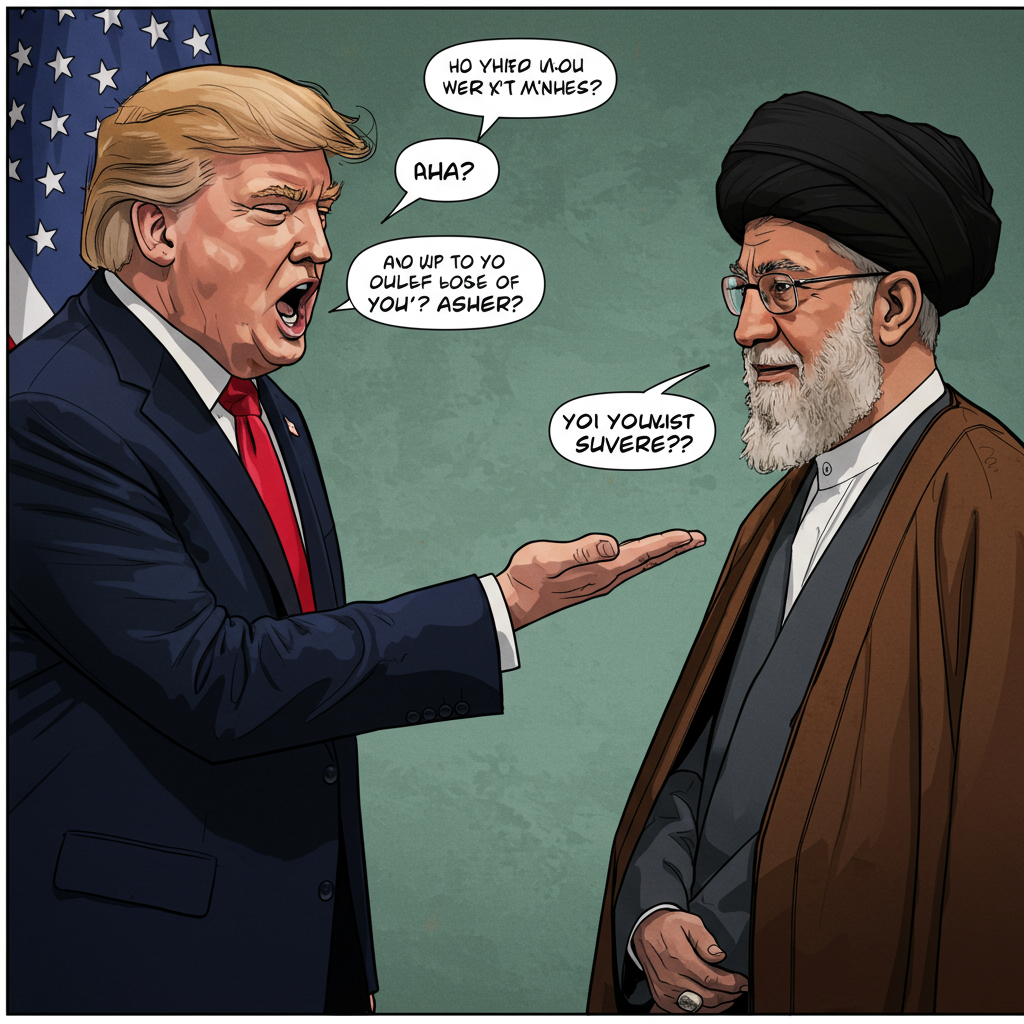Fears of a wider war are mounting in the Middle East as President Trump escalates rhetoric with Iran, demanding “unconditional surrender” even as his administration weighs potential direct military strikes against the country. Iran’s Supreme Leader, Ayatollah Ali Khamenei, has defiantly rejected the ultimatum, vowing firm resistance against what he calls Israeli aggression and warning of “irreparable damage” should the United States intervene.
This high-stakes exchange unfolds amidst the sixth day of intensified conflict between Israel and Iran, a confrontation marked by unprecedented directness and strategic shifts in the region.
The Standoff: Trump’s Demand Meets Iran’s Defiance
In a series of striking statements and social media posts, President Trump has significantly ratcheted up pressure on Tehran. He explicitly called for Iran’s “unconditional surrender” to bring an end to hostilities, stating he seeks “An end. A real end. Not a ceasefire.” Trump also issued a direct threat against Ayatollah Ali Khamenei, declaring on social media that the U.S. knows his location and he is an “easy target,” though adding, “we are not going to take him out (kill!), at least not for now.” He warned that U.S. patience was “wearing thin” regarding potential attacks on civilians or American troops.
Ayatollah Khamenei responded forcefully in a televised address, his first public remarks since the escalation began. He dismissed Trump’s threats and the call for surrender. “Intelligent people who know Iran, the nation and the history of Iran will never speak to this nation in the language of threats, because the Iranian nation cannot be surrendered,” Khamenei stated. He specifically cautioned the U.S., asserting that “any U.S. military intervention will undoubtedly be accompanied by irreparable damage.” This sentiment was echoed by Iran’s ambassador to the U.N. in Geneva, who warned that Iran had conveyed its readiness to “respond very firmly” if Washington becomes directly involved, defining a “line which, if crossed, there should be a response.”
Trump, having cut short his G7 visit to address the crisis, remained ambiguous about his next steps, telling reporters, “I may do it. I may not do it. I mean, nobody knows what I’m going to do.” He noted that Iran had seemingly reached out, but suggested it was now “very late to be talking.”
Escalating Military Actions: Strikes and Counter-Strikes
While Washington debates its options, Israel has continued its relentless bombing campaign across Iran. Israeli military officials confirmed significant strikes, including an operation involving over 50 warplanes targeting military infrastructure and government buildings in Tehran. Defence Minister Israel Katz vowed to “continue to strike at symbols of governance and hit the Ayatollah regime wherever it may be.”
Crucially, Israel’s strikes have targeted facilities linked to Iran’s nuclear program. The Israeli military claimed hits on a nuclear centrifuge plant in Tehran, a claim corroborated by the U.N.’s nuclear watchdog, the International Atomic Energy Agency (IAEA). The IAEA reported that two centrifuge production facilities were struck: one at the Tehran Research Center and another workshop in Karaj. Israel also reported striking missile production facilities and a university linked to the Revolutionary Guards.
In response, Iran has launched missile and drone barrages at Israel. However, Israel reported high interception rates by its Iron Dome and other defense systems, with limited damage and no immediate reports of casualties from these recent attacks, which appeared less intense than earlier salvos. An Israeli drone was reportedly shot down over Iranian territory, though Israel claimed no significant information breach.
The intensified strikes in Tehran have prompted concern for civilians, with reports of Iranians jamming highways to flee the capital. Meanwhile, basic services like internet access have faced severe disruptions across Iran, with the government reportedly restricting access amidst fears of information spread and cyberattacks. Iran’s state broadcaster even controversially urged citizens to remove WhatsApp, alleging it was collecting user data for Israel – a claim WhatsApp has vehemently denied, citing end-to-end encryption.
US Weighs Direct Intervention: Targeting Iran’s Nuclear Program?
A key factor pushing the U.S. closer to potential intervention is Israel’s desire to cripple Iran’s nuclear capabilities, which it considers an existential threat. While Israeli strikes have damaged some sites, effectively neutralizing heavily fortified underground facilities like Fordo requires specialized weaponry. Israeli officials have long pressed the U.S. for access to its largest “bunker-buster” bombs, considered necessary for the job.
Sources familiar with internal discussions indicate the Trump administration is actively considering joining Israel in strikes against Iran’s nuclear sites. Potential U.S. action could involve using B-2 stealth bombers equipped with Massive Ordnance Penetrator bombs. Such a move would represent a significant shift from Trump’s previous stance, which often favored de-escalation and sought a new nuclear deal after withdrawing from the 2015 agreement.
Trump publicly contradicted his Director of National Intelligence regarding Iran’s nuclear ambitions, dismissing an assessment that Iran is not currently building a weapon and insisting Iran is “very close” to having a nuclear bomb. Some U.S. officials worry that Israel’s aggressive campaign might paradoxically incentivize Iran to pursue a nuclear deterrent, increasing pressure on the U.S. to act.
Potential Regional Fallout and US Readiness
Should the United States enter the conflict, intelligence reports reviewed by U.S. officials indicate that Iran has prepared missiles and other assets to target American bases and assets across the Middle East. Iranian officials have explicitly warned that any U.S. intervention would trigger attacks on U.S. forces in countries like Iraq, Syria, Jordan, Bahrain, Qatar, and the United Arab Emirates. There are also concerns Iran could attempt to mine the Strait of Hormuz.
In preparation, the U.S. has increased alert levels for its troops in the region and reportedly deployed additional capabilities, including a significant number of tanker aircraft from the U.S. to Europe, movements some analysts interpret as a form of “strategic ambiguity” designed to pressure Iran. The U.S.S. Carl Vinson aircraft carrier is also positioned in the Arabian Sea.
Domestic US Debate: War Powers on Capitol Hill
The prospect of direct U.S. military action against Iran has reignited a debate on Capitol Hill over presidential war powers. A bipartisan group of lawmakers in both the House and Senate has introduced resolutions demanding congressional authorization before U.S. forces can engage in offensive attacks against Iran. This effort, led by figures like Representatives Ro Khanna (D-CA) and Thomas Massie (R-KY), alongside Senator Tim Kaine (D-VA), underscores concerns that the decision for war should not rest solely with the executive branch. The debate also highlights divisions within President Trump’s political base, with some isolationist voices questioning further U.S. entanglement in foreign conflicts.
The Wider Strategic Context
Analysts view the current conflict as indicative of a profound shift in the Middle East’s power dynamics and Israel’s military doctrine, particularly since the Hamas attacks in October 2023. After years of avoiding all-out war with major adversaries, Israel is now undertaking broader and more brazen attacks, aiming to decisively counter regional threats and undermine Iran’s alliance network. While this aggressive posture has significantly impacted regional groups like Hezbollah and potentially altered the balance of power, questions remain about whether it can achieve a lasting resolution regarding Iran’s nuclear program or avoid devolving into an intractable conflict. As one expert noted, “Time will tell” if effective military action is matched by a sober political vision.



